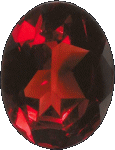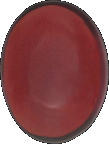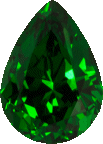| |
Garnet
|
The Garnet receives its name from the Greek granatum meaning pomegranate seed. This was both because of the stone’s physical similarity to the seeds of the Punica granatum and because the stones tend to appear in clusters in deposits. Though garnets can occur in almost any color, most of the mythology surrounding the garnet refers to the red variety of the stone. The traditional name for the garnet, carbuncle, was also applied to most red stones. In time it came to mean specifically stones in the garnet family though, like today, rubies were often mistaken for garnets and vice versa. The term garnet family is important in folkloric texts because even today the word garnet denotes several different stones with similar physical properties but different chemical makeups. This includes every thing from the deep red pyrope and almandine to the green grossular and tsavorite garnets.
The confusion with the ruby has also caused conflation with the folklore of the garnet. Some lapidaries consider a clear deep red stone a ruby, and a cloudy or less perfect stone a garnet. Many often consider the ruby a type of garnet because of its appearance. Moreover, the word carbuncle can refer a stone that is cut in cabochon with the bottom hollowed out to enhance the color of the stone. The loosely defined taxonomy means that it is often difficult to tell exactly what stone a lapidary is describing without physical description. Indeed, sections on garnets found in many lapidaries are more focused on trying to differentiate the garnet from the ruby or other red stones, rather than the virtues of the garnet itself.
None the less there are some specific aspects that are repeated in most lapidaries. The garnet’s association with fire is even more clearly defined than the rubies. There are stories of the garnet glowing in darkness, or reflecting so much light during the day that it scares off fishes or blinds people. The association betwixt the garnet and the flame is so great, that it is said to enable one to see in the dark by its glow, ignite the flames of passion, and even cause water to boil by simply dropping in a garnet cabochon.
Interestingly, there were reports of these stones even being used as bullets by various people. Several Asiatic tribes believed that garnet would cause wounds worse than lead, and that these wounds would not heal. This belief is similar to one held by many north American indigenous nations, who believed a wound caused by garnet would not stop bleeding and so it was preferred as shot. However, it is unknown if this was a pre-Columbian belief or later cultural transference.
|
Colors
|
Green or various shades of red
|
Locations
|
Sri Lanka, Thailand, India, Madagascar, Brazil, Africa, and the USA
|
Compisition
|
Various, garnet is a common name for several different stones with similar physical and visual characteristics
|
Hardness
|
6 - 7
|
|

|

|

|
|
|
|
|
|